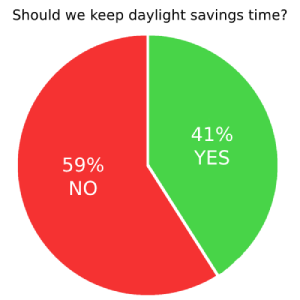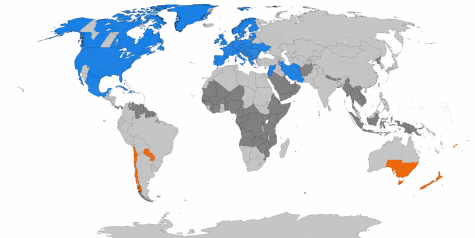Students support the worldwide move to end daylight saving time
Credit: Melissa Preston
People are lamenting the loss of daylight as it gets darker earlier. In December the sun fully sets around 5:30 p.m.
January 19, 2021
The first Sunday in November has made our internal clocks skip backward for years. You wake up feeling like you slept in, but the clock reads an hour earlier than you thought. Then you start the long process of changing every clock in the house to match our “fall back” into Standard Time.
In a survey taken from 95 Loy Norrix students, 56 said that we should get rid of daylight savings. Other countries have taken, or plan on taking, this step as well, raising the question of whether or not the U.S. should keep switching the clock.

“It’s dark too early, 5:00 p.m. should not be dark,” said Loy Norrix senior Katie Kutzko. She shares the same views as the slight majority of participants in this poll who voted that switching time because of daylight saving should end.
About two thirds of these students don’t see the need for daylight savings time anymore, while the rest don’t see a need to get rid of it. Some agreements drawn by these teenagers are that daylight saving time is old and no longer relevant, negatively impacts mental and physical health, confusing, throws off the internal rhythm and makes it dark way too early.
However, on the other side of the scale, 39 of the participants think daylight savings should stay. These students agreed that more time in the day can help them feel more productive, daylight savings time has been around and working for a long time, it’s better for business, it helps keep electricity down and it helps the days fit the seasons.
Loy Norrix senior Nolan Hughes agrees that daylight saving time has been kept longer than it should have been.
“It was used to expand the work day, before we had [sustainable] lights. Especially in the case of farmers, you couldn’t exactly bring a torch or a lantern into a crop field, but now that most people don’t work in agriculture and we have lights that let people stay productive well into the night, we don’t really need daylight saving anymore,” Hughes said.
Another common argument against daylight savings is that changing the clocks negatively impacts mental health.
“It makes it harder on people with seasonal affective disorder. I think for this year in particular, with everything happening in the world, [a] global pandemic causing deaths in families, [causing] us to isolate from each other and stopping us from enjoying activities we love, and for people who pay attention to our country’s current political atmosphere, that sure doesn’t help our mental health,” Hughes said. “Losing that extra hour of sunlight later in the day just can be another thing that can feel depressing in our lives as we live through this time period.”
The COVID-19 pandemic has forced us all to stay inside, so that extra hour of sunlight in the evening has definitely been missed. People have also found themselves changing their schedules to accommodate the quarantine, which has led them to see how much daylight saving time impacts them, more than they normally would.
“I don’t see why we shouldn’t just keep the natural cycle and leave it. It’s confusing otherwise and it tends to mess up schedules as well,” said junior Zoie McDade.
Brazilian President Jair Bolsonaro holds the same views as these teenagers, since last year he signed away with daylight saving time for all of Brazil.
“Even if it was only an hour, it messed with people’s biological clocks,” Bolsoanro said at the signing.
Although a poll was taken and 55% of Brazilians voted to abolish daylight saving time, this change might not have been what they expected. According to the article “Brazil eliminated daylight saving time. Now it’s light out before 5 a.m., and people aren’t happy” by Terrence McCoy, many people miss daylight saving or are still changing their clocks, despite the country’s decision.
“The same went for Julia Reis, who in the beginning ignored the government and continued living [in] daylight saving time, despite all obstacles. ‘The best thing I’ve done,’ she called it in a piece for Vice’s Portuguese-language website. She said she knew an hour didn’t seem like much, but for her, it made all the difference,” McCoy wrote.

Brazil isn’t the only country that’s gotten rid of daylight saving time. As of November 2020, this map shows all the countries that still have daylight savings (indicated in blue and orange, depending on hemisphere), the countries that used to implement daylight saving time but don’t anymore (light grey) and countries that never used daylight savings time (dark grey).
With the advancements in technology and progressive culture, we’re seeing a lot of countries ending daylight saving and just adopting one time instead.
In 2019, the European Parliament voted to end daylight saving time by 2021. They are going to allow the different members to choose to stay in either Standard Time or Daylight Saving Time, meaning the countries in the EU won’t change their clocks anymore. The article “European parliament votes to scrap daylight saving time from 2021,” by Daniel Boffey talks about the European Union’s plans and how they’ll impact the countries, specifically England. Although, since England has left the EU, this time change might not impact them.
“We welcomed the decision some years ago to ensure that, when the clocks do change across Europe, they do so on the same day, but have consistently argued that this is ultimately a matter for an individual country,” said Jacqueline Foster, a spokesperson in the Parliament. “This move is unwanted and unnecessary. With all of the problems and challenges facing the EU at present, one would have thought that the commission’s focus would be elsewhere.”
All these different factors raise the question, will the U.S. get rid of daylight saving time?
As of right now, “states can exempt themselves from Daylight Saving Time, as Hawaii and Arizona (except on Navajo tribal lands) have done, but federal law prohibits states from adhering to Daylight Saving Time the entire year,” according to Andrew J. Tobias in his article “Ohio General Assembly passes resolution urging Congress to keep Daylight Saving Time year-round”.
This has been the case with Ohio. Just last month, the Ohio House of Representatives voted to pass an act that would set Ohio in daylight saving time permanently. Although, this act cannot be carried out until the Ohio representatives get congressional action. Urging Congress to end daylight saving seems to be becoming popular, as Ohio is now the 14th state to take this step.

Current American president Donald Trump also made a tweet in March 2019 agreeing with making Daylight Saving Time permanent. This means he agrees with the idea that people in the U.S. won’t set their clocks forward or backwards anymore, but instead will stay an hour ahead of Standard Time, like we currently do in the spring.
While debating the time might not seem very important right now, daylight saving time is on the minds of many people around the world as the days are getting shorter and winter is approaching.













Len Loomans • Mar 13, 2021 at 10:18 pm
Let me back up a bit and say thanks to Melissa for a very well researched article. As you can tell, I’m passionate about this issue, which is why I was pleased to find and read your article. I agree with a consistent universal time zone system across the globe, and whether its an hour this way or that seems pretty arbitrary. Thanks again, Len
Len Loomans • Mar 13, 2021 at 8:01 pm
Adjusting our clocks back and forth during spring and fall is insane. The natural sine wave of hours of sunlight over the entire planet is perfect. I understand and respect the origins of the practice, but it’s no longer has relevance to our global society. At all latitudes, we need to adjust our activities and schedules to our annual progression around the sun. Why is this still an issue? Len